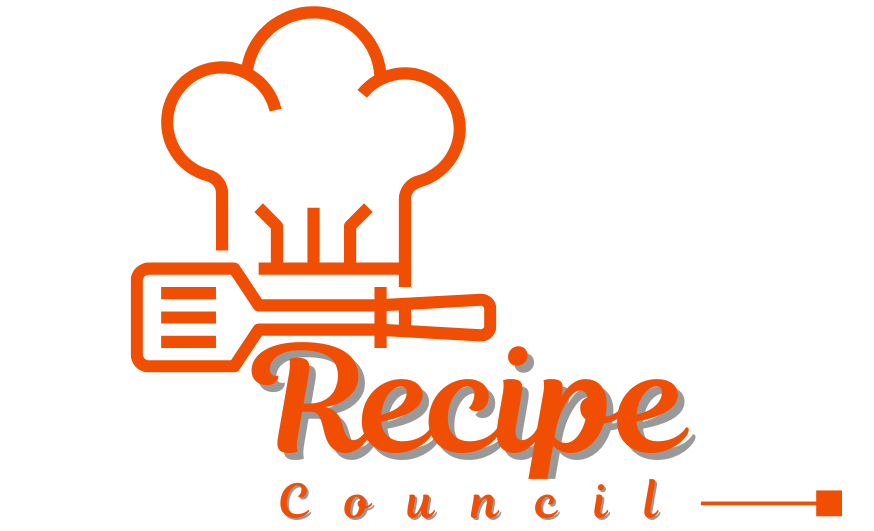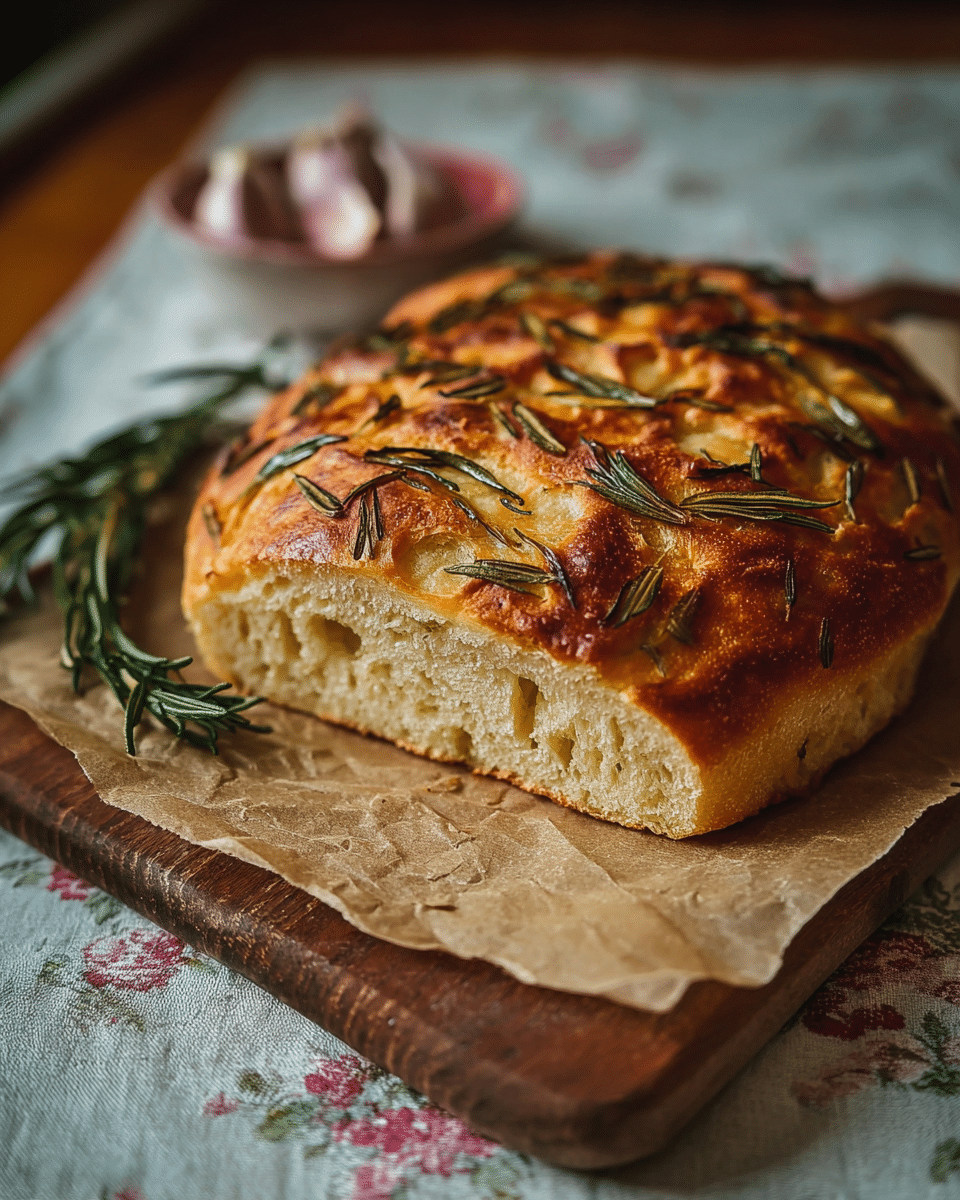There’s something magical about baking bread at home – the aroma, the anticipation, and finally that first slice of warm, golden crust. This Rustic No-Knead Rosemary Garlic Bread delivers all of that magic with minimal effort. Its long, slow rise develops incredible flavor, while fresh rosemary and garlic infuse the loaf with savory notes that make each bite irresistible. The beauty of this bread lies not only in its simplicity but also in its versatility. Whether you serve it alongside a hearty stew, use it as the base for bruschetta, or enjoy it toasted with butter, it’s a recipe that elevates even the simplest meals. Plus, the Dutch oven baking method creates that perfect artisan-style crust right in your own kitchen. Once you try it, this loaf is sure to become a regular in your baking rotation.
Full recipe:
Ingredients:
-
3 cups all-purpose flour
-
1 ½ teaspoons salt
-
½ teaspoon instant yeast
-
1 ½ cups warm water
-
2 cloves garlic, minced
-
2 teaspoons fresh rosemary, chopped (or 1 teaspoon dried)
-
Extra flour for dusting
Directions:
-
In a large mixing bowl, combine flour, salt, yeast, garlic, and rosemary.
-
Pour in warm water and stir with a wooden spoon until a shaggy dough forms. Do not knead.
-
Cover the bowl with plastic wrap or a clean kitchen towel and let it rest at room temperature for 12–18 hours, until doubled in size and bubbly.
-
Preheat the oven to 450°F (230°C). Place a Dutch oven with its lid inside the oven to preheat for 30 minutes.
-
Meanwhile, turn the dough out onto a well-floured surface. Shape it gently into a round loaf. Cover with a towel and let rest while the Dutch oven heats.
-
Carefully remove the Dutch oven, place the dough inside, cover with the lid, and bake for 30 minutes.
-
Remove the lid and bake an additional 10–15 minutes until the crust is golden brown.
-
Allow bread to cool on a wire rack for at least 15 minutes before slicing.
Prep Time: 10 minutes | Rising Time: 12–18 hours | Cooking Time: 45 minutes | Total Time: ~13–19 hours
Kcal: 160 kcal (per slice, approx.) | Servings: 12 slices
Introduction
There’s something deeply comforting about the smell of freshly baked bread wafting through the kitchen. Few things can transport us to a place of warmth, nostalgia, and joy like bread. Among the many bread variations, Rustic No-Knead Rosemary Garlic Bread stands out for its ease, flavor, and artisanal look. This bread is not just food—it is a culinary experience that connects tradition with simplicity. With just a handful of ingredients and minimal effort, you can produce a loaf that looks like it belongs in a European bakery display.
The beauty of this bread lies in its “no-knead” technique. Traditionally, bread baking required strong hands and long sessions of kneading to develop gluten and achieve that perfect chewy texture. The no-knead method, however, uses time instead of effort. A long fermentation period allows gluten strands to form naturally, resulting in a structure that is airy inside and crusty outside. When paired with fresh rosemary and garlic, this bread achieves a complexity of flavor that rivals even the most sophisticated loaves.
A Brief History of No-Knead Bread
The concept of no-knead bread rose to fame thanks to Jim Lahey of Sullivan Street Bakery in New York City. In 2006, he introduced the world to an easy bread recipe that relied on time and patience instead of traditional kneading. The idea was revolutionary: combine flour, yeast, water, and salt, let it sit for hours, and then bake it in a hot Dutch oven. The result was a loaf with a professional-looking crust and flavor that felt like it came straight from the hands of a seasoned baker.
Since then, variations of no-knead bread have been developed all around the world. The Rustic No-Knead Rosemary Garlic Bread is one of those special versions. By adding fragrant rosemary and savory garlic, the bread elevates itself from simple to gourmet. This combination not only enhances flavor but also offers health benefits, making it a bread that nourishes both the body and the soul.
Why Rosemary and Garlic Are a Perfect Pair
Rosemary and garlic are a timeless culinary pairing. Their flavors complement one another beautifully, and together they create a bread that is rich, savory, and aromatic. Rosemary brings a piney, slightly peppery note that adds depth to baked goods. Garlic, on the other hand, infuses the bread with warmth, richness, and umami undertones.
This pairing is often used in Mediterranean cuisine, particularly in Italy and France, where bread, herbs, and olive oil play central roles in daily life. Incorporating rosemary and garlic into bread creates not only a flavorful experience but also a cultural connection to centuries-old food traditions.
Health Benefits of Rosemary Garlic Bread
This rustic bread is more than a treat for the taste buds—it can also be good for your health. Rosemary contains antioxidants and anti-inflammatory compounds that can improve digestion, enhance memory, and even strengthen the immune system. Garlic, often called a superfood, is known for its antibacterial, antiviral, and heart-healthy properties. Studies have shown that garlic can reduce cholesterol, improve cardiovascular health, and support the immune system.
Combined with the slow fermentation process, which enhances digestibility, this bread becomes a healthier alternative to heavily processed store-bought loaves. The no-knead technique allows natural enzymes and yeast to break down gluten and phytic acid, making nutrients more bioavailable. This makes each bite not just delicious, but nourishing.
The Secret Behind the Perfect Crust
One of the most impressive features of this bread is its crust. Golden brown, crisp, and slightly crackly, the crust is what gives the bread its rustic appeal. The secret lies in the Dutch oven method. By baking the dough in a preheated, lidded Dutch oven, steam is trapped inside, mimicking the environment of professional bread ovens. This steam keeps the crust moist in the beginning stages of baking, allowing the bread to expand fully. Once the lid is removed, the crust hardens, resulting in that signature crunch we all love.
It’s a process that is simple yet produces professional-quality results. Even if you’ve never baked bread before, this method will make you look like a seasoned baker.
Why This Bread is Beginner-Friendly
Many people shy away from bread baking because they think it’s too complex or intimidating. That’s where this recipe shines. There is no kneading, no complicated steps, and no special equipment beyond a Dutch oven. The ingredients are pantry staples—flour, yeast, salt, water, garlic, and rosemary. The most challenging part is waiting for the dough to rise overnight.
This makes it a perfect recipe for beginners who want to try their hand at bread baking. It teaches patience, rewards effortlessness, and provides a sense of accomplishment when you pull that golden loaf from the oven. Once you’ve mastered this recipe, you’ll feel confident enough to explore other variations and flavor profiles.
Versatility in Serving
Rustic No-Knead Rosemary Garlic Bread is one of the most versatile breads you can make. Its flavors pair well with almost anything. Serve it alongside a steaming bowl of soup or stew, and it becomes the perfect dipping bread. Toast slices and top them with bruschetta mix for a Mediterranean appetizer. Spread butter or drizzle olive oil on it for a simple snack that’s bursting with flavor.
It’s also ideal for sandwiches. The sturdy crust holds fillings well, while the soft, chewy inside makes every bite satisfying. Pair it with roasted vegetables, cheeses, or grilled meats, and you’ll have a sandwich that feels gourmet.
The Joy of Homemade Bread
Baking bread at home is not just about the final product—it’s about the process. Mixing simple ingredients, watching the dough rise, and finally pulling a golden loaf out of the oven brings immense satisfaction. It’s a reminder of the beauty of slow food, where time and care replace convenience.
This bread also makes your kitchen smell incredible. The fragrance of garlic and rosemary fills the air, creating a sense of warmth and anticipation. It’s not just baking; it’s creating an atmosphere of comfort and love. Sharing homemade bread with family and friends is one of the simplest yet most meaningful acts of hospitality.
Customization Ideas
While this recipe is perfect as it is, you can also customize it to your liking. Try adding roasted garlic for a sweeter, milder flavor. Swap rosemary for thyme, sage, or oregano for a different herbal profile. Add a sprinkle of Parmesan cheese into the dough for an extra savory twist. For those who enjoy a nutty crunch, sunflower seeds or walnuts can be folded in before baking.
The beauty of this bread lies in its flexibility. Once you’ve mastered the base recipe, the possibilities are endless. Each variation gives you a new flavor experience while still maintaining the simplicity of the no-knead method.
Why This Bread is the Best
When compared to other bread recipes, Rustic No-Knead Rosemary Garlic Bread has clear advantages. It requires little effort, yet the results are spectacular. It’s healthier than many store-bought breads, thanks to its simple ingredient list and long fermentation. Its flavor is rich, complex, and deeply satisfying, without the need for additives or preservatives.
Moreover, the bread has that sought-after artisan look: crackly crust, rustic scoring, and a beautiful round shape. It looks impressive on any dining table and tastes even better. Whether you’re baking for yourself, your family, or guests, this bread makes a statement. It shows care, effort, and a love for good food.
Conclusion
Rustic No-Knead Rosemary Garlic Bread is more than just a recipe—it’s a journey into the art of simple, soulful baking. With minimal effort and a little patience, you can create a loaf that looks like it came straight from an artisan bakery. Its golden crust, fragrant rosemary, and savory garlic make every slice a delight for the senses. From its health benefits to its versatility, this bread proves that homemade is always worth the effort. It connects us to tradition, brings joy to the kitchen, and offers nourishment beyond just calories. Whether you’re new to bread baking or a seasoned baker, this recipe is one you’ll return to again and again.






